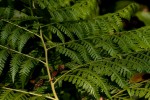Microlepia speluncae
Selected images: Click on each image to see a larger version and details of the record View all images (8)
Detailed records: Display species records QDS maps by: Google Maps Point records by Google Maps
Species details: Click on each item to see an explanation of that item (Note: opens a new window)
| Synonyms: |
Aspidium speluncae (L.) Willd. Davallia speluncae (L.) Baker Polypodium speluncae L. |
| Common names: | |
| Frequency: | Rare |
| Status: | Native |
| Description: |
Rhizome widely creeping, 5-10 mm diameter; rhizome hairs few, pale, up to 4 mm long. Fronds widely spaced, membranous. Stipe up to 1 m long, brown, glabrous at maturity. Lamina 1.5 × 1 m, 4-pinnatifid to 4-pinnate, triangular in outline. Ultimate segments oblong-lanceolate, with rounded apex and lobed margins, both surfaces and costules with few, soft hairs. Sori circular, 1 mm diameter, situated at the end of the veins, which also bear a clear gland on the upper surface; indusium cup-shaped and facing outwards. |
| Type location: |
|
| Notes: | It can be distinguished from Hypolepis sparsisora by having a thinly pubescent lamina and pinna that stand in the same plane as the main axis. Microlepia speluncae favours shaded areas whereas Hypolepis sparsisora lives in areas with high-light conditions. |
| Derivation of specific name: | speluncae: from spelunca, a cave, referring to the sporangia sheltered in the cup-shaped indusium or less likely to the deeply shaded habitat of this fern. |
| Habitat: | In moist conditions in semi-deciduous forest, evergreen forest, swamp forest and marshes, mostly in shaded habitats. |
| Altitude range: (metres) | Up to 1650 m |
| Worldwide distribution: | Widespread in Africa, also in the Madagascan region, pantropical. |
| FZ divisions: | Z,MS |
| Growth form(s): | Terrestrial. |
| Endemic status: | |
| Red data list status: | |
| Insects associated with this species: | |
| Spot characters: | Display spot characters for this species |
| Images last updated: | Thursday 8 December 2011 |
| Literature: |
Burrows, J.E. (1990). Southern African Ferns and Fern Allies. Frandsen, Sandton. Page 106. (Includes a picture). Burrows, J.E. & Burrows, S.M. (1993). An annotated check-list of the pteridophytes of Malawi Kirkia 14(1) Page 85. Chapano, C. & Mamuto, M. (2003). Plants of the Chimanimani District National Herbarium and Botanic Garden, Zimbabwe Page 39. Crouch, N.R., Klopper, R.R., Burrows, J.E. & Burrows, S.M. (2011). Ferns of Southern Africa, A comprehensive guide Struik Nature Pages 282 - 283. (Includes a picture). Da Silva, M.C., Izidine, S. & Amude, A.B. (2004). A preliminary checklist of the vascular plants of Mozambique. Southern African Botanical Diversity Network Report No. 30 Sabonet, Pretoria Page 10. Fischer E. & Lobin W. (2024). Checklist of Lycopodiopsida (clubmosses and quillworts) and Polypodiopsida (ferns) of Rwanda. Willdenowia 53(3) Page 160. Germishuizen, G. & Meyer, N.L. (eds) (2003). Plants of southern Africa: an annotated checklist. Strelitzia 14 Page 70. Jacobsen, W.B.G. (1983). The Ferns and Fern Allies of Southern Africa. Butterworths, Durban and Pretoria. Pages 210 - 211. (Includes a picture). Kornas, J. (1979). Distribution and ecology of the Pteridophytes in Zambia Polska Akademia Nauk Wydzial II Nauk Biologicznych Pages 81 - 82. Mapaura, A. & Timberlake, J. (eds) (2004). A checklist of Zimbabwean vascular plants Southern African Botanical Diversity Network Report No. 33 Sabonet, Pretoria and Harare Page 6. Ntore, S. & al. (2024). Checklist of the vascular plants of Burundi Page 30. Roux, J.P. (2001). Conspectus of Southern African Pteridophyta. Southern African Botanical Diversity Network Report 13 Page 89. (Includes a picture). Roux, J.P. (2009). Synopsis of the Lycopodiophyta and Pteridophyta of Africa, Madagascar and neighbouring islands Page 111. Schelpe, E.A.C.L.E. (1970). Pteridophyta Flora Zambesiaca Pages 89 - 92. (Includes a picture). Setshogo, M.P. (2005). Preliminary checklist of the plants of Botswana. Sabonet Report no. 37. Sabonet, Pretoria and Gaborone Page 15. Timberlake, J.R. & Childes, S.L. (2004). Biodiversity of the Four Corners Area: Technical Reviews Volume Two (Chapter 5-15) Appendix 5-1: Plant Checklist Occasional Publications in Biodiversity 15 Page 179. |
Other sources of information about Microlepia speluncae:
Our websites:
Flora of Botswana: Microlepia speluncaeFlora of Burundi: Microlepia speluncae
Flora of Caprivi: Microlepia speluncae
Flora of Malawi: Microlepia speluncae
Flora of Rwanda: Microlepia speluncae
Flora of Zambia: Microlepia speluncae
Flora of Zimbabwe: Microlepia speluncae
External websites:
African Plants: A Photo Guide (Senckenberg): Microlepia speluncaeAfrican Plant Database: Microlepia speluncae
BHL (Biodiversity Heritage Library): Microlepia speluncae
EOL (Encyclopedia of Life): Microlepia speluncae
GBIF (Global Biodiversity Information Facility): Microlepia speluncae
Google: Web - Images - Scholar
iNaturalist: Microlepia speluncae
IPNI (International Plant Names Index): Microlepia speluncae
JSTOR Plant Science: Microlepia speluncae
Mansfeld World Database of Agricultural and Horticultural Crops: Microlepia speluncae
Plants of the World Online: Microlepia speluncae
Tropicos: Microlepia speluncae
Wikipedia: Microlepia speluncae

